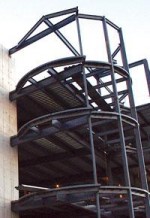New ROTC building set to open this fall

The hulk of steel beams and concrete on Maple Drive might not attract as much attention as the construction of the new Phyllis P. Marshall Center, with its familiar ring of pile driver shots, but the relative silence marks a different type of progress.
Next fall, USF will open the Joint Military Leadership Center (JMLC), the first joint Reserve Officer Training Corps (ROTC) building in the nation that has the potential to increase the University’s visibility and strengthen its constituent training programs, said Luis Visot, executive director of the JMLC.
Visot, a brigadier general in the Army Reserves, said USF has the rare privilege of hosting all three ROTC programs (Naval, Army and Air Force) under one academic roof and has an advantageous location – near MacDill Air Force Base, a hub for Central Command and Southern Command Headquarters in Miami, which are both examples of joint effort.
“There are only 328 universities in the country that sponsor the ROTC program, and of those, only 38 have all three,” Visot said.
The JMLC will free up classroom space in the Behavioral Sciences, Social Sciences and Human Services buildings. There will be three new auditoriums and several classrooms, as well as a student lounge designed to encourage ROTC solidarity and the exchange of ideas between each branch. The building will also serve as a memorial to the victims of the Sept. 11, 2001 terrorist attacks and will include a shard of steel from the World Trade Center, a heap of soil from the crash site in Pennsylvania and a chunk of marble from the wall of the Pentagon.
According to Visot, the $10.3 million center is funded in part by federal grant money appropriated by Rep. C.W. Bill Young, R-Fla. It will allow all three ROTC programs to study together while providing more general classroom space for all USF students. It will also house a new academic minor – national security studies – to all students.
“(It) will be a good fit for students interested in public policy or intelligence, by which they’ll develop a better understanding of military procedure,” Visot said.
The minor, still under development in a partnership with the Department of Defense, will feature one class from each ROTC program, including two exclusive “capstone” courses. Visot said it could stimulate the interest of students pursuing degrees as diverse as political science, international studies and anthropology.
According to senior and Air Force ROTC member Brian Hartz, since the reality of warfare today is joint strategy, such a program will better serve ROTC cadets and the U.S. military.
Hartz said it is a hindrance for freshly commissioned officers to spend most of their careers engaged in multi-service work without adequate preparation on the pre-commission level. Nevertheless, ROTC curricula will remain largely unchanged. The center will complement ROTC education by giving each cadet an understanding of the limits and capabilities of the sister services.
The need for joint-education centers such as the JMLC stems from general changes in military organization and strategy. This is spurred by the Goldwater-Nichols Act, which has been gradually implemented since the law’s passage in 1986. Among other things, the law directs, for the creation of regional areas of responsibility that put all four branches of the armed forces at the disposal of a single commander in chief. The most well known is Central Command, which is responsible for operations in the Middle East.





